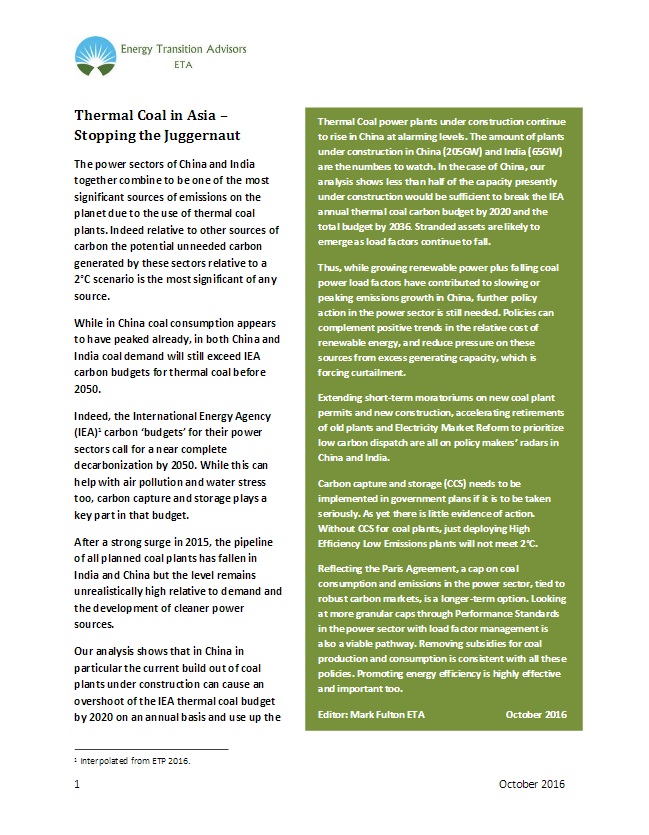Thermal Coal in Asia – Stopping the Juggernaut
The power sectors of China and India together combine to be one of the most significant sources of emissions on the planet due to the use of thermal coal plants. Indeed relative to other sources of carbon the potential unneeded carbon generated by these sectors relative to a 2°C scenario is the most significant of any source.
While in China coal consumption appears to have peaked already, in both China and India coal demand will still exceed IEA carbon budgets for thermal coal before 2050. Indeed, the International Energy Agency (IEA) carbon ‘budgets’ for their power sectors call for a near complete decarbonization by 2050. While this can help with air pollution and water stress too, carbon capture and storage plays a key part in that budget.
After a strong surge in 2015, the pipeline of all planned coal plants has fallen in India and China but the level remains unrealistically high relative to demand and the development of cleaner power sources.
Our analysis shows that in China in particular the current build out of coal plants under construction can cause an overshoot of the IEA thermal coal budget by 2020 on an annual basis and use up the whole of the budget available till 2050 by 2036. India does so in the 2030s even with no new power plants developed post those under construction now.
While India, in particular, believes it needs more room in carbon budgets for equity reasons - implying further cuts to OECD coal use - this paper looks at the power sector solutions that are both viable (renewable energy) and need further proving (Carbon Capture and Storage). There is no doubt that both India and China have comprehensive policies to stimulate cleaner energy, efficiency and further policy changes would be highly desirable to support these trends by constraining unneeded thermal coal and developing green financing markets.
Section 1: Recent Demand and Supply Trends in Thermal Coal in China and India
1.1 Summary
In China, 2016 has seen a trend towards an increase in pre-construction power stations being shelved or cancelled, but also an increase in actual plants under construction. Meanwhile, evidence is growing that coal consumption may have peaked in the past two years, with the energy intensity of GDP falling as a result of the rebalancing of the economy.
Recent announcements, including a partial moratorium on new power plant permitting and construction, have been encouraging. Some 114GW of pre-construction coal power plant capacity has been cancelled or shelved this year. Nevertheless, 2015 saw a massive surge in permitted thermal coal fired stations at the local level in China, as permitting powers were passed to the provinces. That surge leaves 205GW still under construction today, even while the economics of the sector look challenging.
Low coal prices and supportive tariffs allow many coal plants to be profitable even at low load factors. However, tariffs are falling in China,as regulators send a signal to curtail new build, which leaves the sector increasingly vulnerable to economic stranding, given falling load factors that have already fallen to 46%. Estimates have put unneeded coal plant expenditures at around $200bn by 2020. Renewable energy continues to scale up but dispatch has been curtailed, a problem which needs to be addressed in dispatch reforms.
Indian developments remain ambivalent, reflecting an ‘all of the above’ energy policy approach that includes renewables,but also still seeks to develop coal aggressively with 65GW under construction, even after a reduction of the pre-construction in the pipeline of 40GW up to July this year. Indeed there have been announcements of cancellations of ‘mega’ projects, and local opposition around land use is evident in India. Renewable energy has seen strong gains and can go much further. However, longer-term demand for electricity remains high.
In both India and China, there is a tussle between domestic coal production and imported seaborne coal. China was reducing domestic production earlier in the year, while India has been trying to boost domestic production. Seaborne coal prices have been rising, but very recent announcements to increase domestic production in China again put this under pressure.
For more information and to download the full report, please click here.

